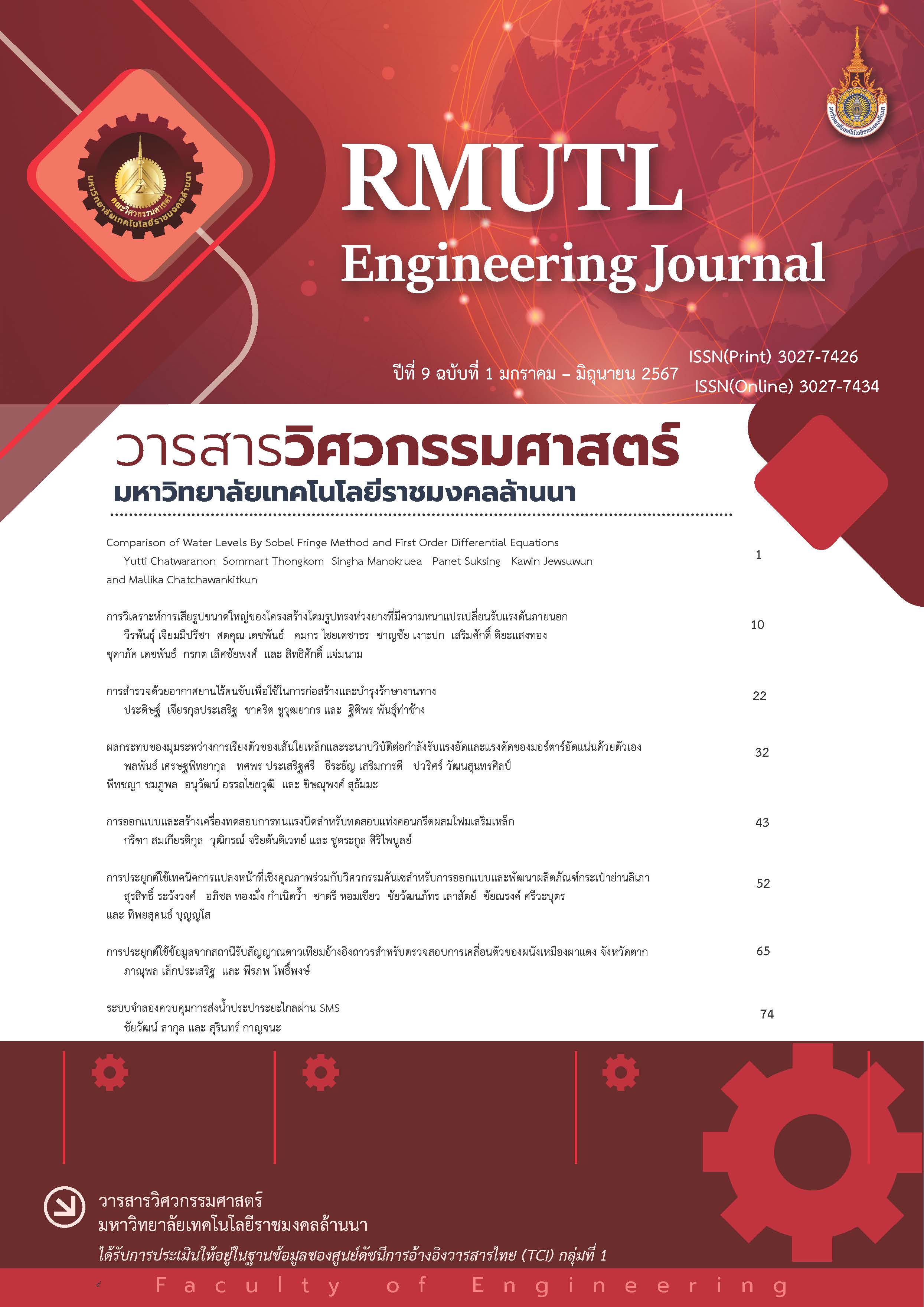การประยุกต์ใช้เทคนิคการแปลงหน้าที่เชิงคุณภาพร่วมกับวิศวกรรมคันเซสำหรับการออกแบบและพัฒนาผลิตภัณฑ์กระเป๋าย่านลิเภา
DOI:
https://doi.org/10.14456/rmutlengj.2024.6คำสำคัญ:
กระเป๋าสตางค์, ย่านลิเภา, การออกแบบผลิตภัณฑ์, การแปลงหน้าที่เชิงคุณภาพ, วิศวกรรมคันเซบทคัดย่อ
งานวิจัยนี้มีวัตถุประสงค์เพื่อพัฒนาและออกแบบผลิตภัณฑ์กระเป๋าสตางค์ย่านลิเภาโดยการประยุกต์ใช้เทคนิคการแปลงหน้าที่เชิงคุณภาพร่วมกับวิศวกรรมคันเซ ด้วยการสำรวจและแปลงความต้องการของลูกค้าที่มีต่อการตัดสินใจซื้อผลิตภัณฑ์ ในการประยุกต์ใช้การแปลงหน้าที่เชิงคุณภาพในส่วนของเมริกซ์การวางแผนผลิตภัณฑ์ เป็นการมุ่งเน้นการแปลงความต้องการของลูกค้าในรูปแบบข้อกำหนดเชิงเทคนิค จึงนำวิศวกรรมคันเซมาสนับสนุนการวิเคราะห์เพิ่มเติมสำหรับการออกแบบผลิตภัณฑ์ที่สื่อถึงอารมณ์ความรู้สึกของลูกค้า ซึ่งเป็นส่วนสำคัญในการพัฒนาผลิตภัณฑ์ ผลการวิจัยพบว่า การพัฒนาผลิตภัณฑ์ในส่วนของการวิเคราะห์การแปลงหน้าที่เชิงคุณภาพได้รับการเปลี่ยนแปลงทางด้านรูปแบบ การใช้งาน วัสดุ คุณภาพ ความสะดวก และราคา โดยในส่วนการวิเคราะห์เชิงปริมาณประเภทที่ 1 ของวิศวกรรมคันเซ ได้รับการเปลี่ยนแปลงคุณลักษณะผลิตภัณฑ์ จำนวน 6 คุณลักษณะผลิตภัณฑ์ คือ ขนาด รูปแบบ ลักษณะกระเป๋า การใช้งาน โทนสี และรูปทรง พร้อมทั้งได้รับการเปลี่ยนแปลงให้ผลิตภัณฑ์มีการออกแบบที่สื่อถึงอารมณ์ความรู้สึกสร้างสรรค์ เรียบง่าย และโดดเด่นน่าสนใจ ดังนั้นสำหรับการพัฒนาและออกแบบกระเป๋าสตางค์ย่านลิเภา พบว่าลูกค้ามีความพึงพอใจในคุณลักษณะด้านแนวทางการสานมากที่สุดเป็นอันดับแรก โดยมีระดับความพึงพอใจอยู่ในระดับดีมากและมีค่าเฉลี่ยเท่ากับ 4.50 และมีความพึงพอใจด้านความรู้สึกเรียบง่ายมากที่สุด โดยมีระดับความพึงพอใจอยู่ในระดับดีมากและมีค่าเฉลี่ยเท่ากับ 4.51
References
Chanmuang N, Anumanee A, Rodjaroen S, Chailikit O, Chuaychai N. Requirements for contemporary Lipao crafts products. Narkbutparitat Journal Nakhon Si Thammarat Rajabhat University. 2022; 14(2): 138-150. Thai.
Rattanapan C. Design of Yan Lipao Handicraft products of Nakhon Si Thammarat Province to suit the needs of the target groups. Academic Journal for the Humanities and Social Sciences Dhonburi Rajabhat University. 2022; 5(2): 86-101. Thai.
Makmee A, Klomjit P. Evaluation of relationship between brake performances, properties of brake pad and hot-pressing process parameters by QFD technique. Naresuan University Engineering Journal. 2020; 15(1): 54-65. Thai.
Thongrak A. Sitjongsataporn S. Kansei engineering: product development methodology. RMUTP Research Journal. 2014; 8(1): 197-204. Thai.
Kanoksirirujisaya N, Poonikom K. Product development using quality conversion technique in the health industry Srinagarind Hospital with the design of 3D automatic transportation vehicles. Princess of Naradhiwas University Journal. 2021; 13(1): 244-261. Thai.
Akao Y. Quality function deployment: integrating customer requirements into product design. SteinerBooks; 2004.
Yodwangjai S. Product design and development process. Journal of Engineering and Innovation. 2015; 8(1): 131-142. Thai.
Trongpanich S, Kengphon A. The improvement of quality in the service of logistics business by using quality function deployment and analytic hierarchy process techniques: A case study of battery logistics. The Journal of KMITNB. 2007; 17(3): 47-56. Thai.
Yodwangjai S. Product design and development for dinner chair of kansei engineering. KKU Engineering Journal. 2014; 41(2): 191-200. Thai.
Faishal M, Mohamad E, Jaafar R, Rahman AA, Adiyanto O, Jatmiko HA, Novera I. Integrated approach to customer requirement using quality function deployment and Kansei engineering to improve packaging design. Asia-Pacific J. Sci. Technol. 2021; 26(2): 1-10.
Nagamachi M. Kansei engineering as a powerful consumer-oriented technology for product development. Applied ergonomics. 2002; 33(3): 289-294.
Schütte S. Designing feelings into products. Linköping Studies in Science and Technology, Thesis. 2002; (946).
Sinthavalai S, Ruengrong S. An application of house of quality (HOQ) for designing rice product as a souvenir. Naresuan University Journal: Science and Technology. 2018; 26(3): 36-51. Thai.
Pasunon P. Validity of questionnaire for social science research. Journal of Social Sciences Srinakharinwirot University. 2015; 18. 375-396. Thai.
Ratner B. The correlation coefficient: Its values range between+ 1/− 1, or do they?. Journal of targeting, measurement and analysis for marketing. 2009; 17(2): 139-142.
Kennedy-Shaffer L. Before p< 0.05 to beyond p< 0.05: using history to contextualize p-values and significance testing. The American Statistician. 2019; 73(1): 82-90.
Bupakdee T, Pachonklaew P. Packaging design for chinese pastries of community products by applying Quality function deployment. Journal of Learning Innovation and Technology. 2022; 2(1): 72-84. Thai.
Ouyang C, Wu KY. A DFA-Based Wood Frame Furniture Design Using Quality Function Deployment: A Case Study in School Open Spaces. International Conference on Chemical, Material and Food Engineering 2015 ;p. 517-520.
Woo JC, Luo F, Lin ZH, Chen YT. Research on the sensory feeling of product design for electric toothbrush based on kansei engineering and Back propagation neural network. Journal of Internet Technology. 2022; 23(4): 863-871.
Rawangwong S, Homkhiew C, Pirom T, Kamnerdwam AT, Boonyaso T. An application of kansei engineering technique for the design and development of leather product: A case study of leather manufacturer, muang district, songkhla province. Journal of Engineering and Innovation. 2022; 15(1): 144-156. Thai.
Lei Q, Zhao QQ, Zhang ZF. Study on the materials design of furniture based on kansei engineering. International Journal of Engineering Innovation & Research. 2015; 4(5): 752-756
Downloads
เผยแพร่แล้ว
How to Cite
ฉบับ
บท
License

This work is licensed under a Creative Commons Attribution-NonCommercial-NoDerivatives 4.0 International License.








